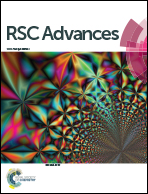Density functional investigations on the catalytic cycle of the hydrogenation of aldehydes catalyzed by an enhanced ruthenium complex: an alcohol-bridged autocatalytic process†
Abstract
A novel ruthenium complex developed by Casey exhibits some outstanding features such as effective anti-dimerization, highlighted catalytic activity and a mild reaction condition. Density functional theory (DFT) was used to explore the catalytic cycle of the hydrogenation of PhCHO catalyzed by this enhanced ruthenium complex. The catalytic cycle of aldehyde hydrogenation involves two stages, hydrogen transfer and regeneration of the active catalyst, which can be achieved by means of a concerted outer-sphere hydrogen transfer and an intramolecular hydrogen migration, respectively. Hydrogen transfer is the rate-determining step in the total catalytic hydrogenation cycle, having a low free energy barrier of 16.2 kcal mol−1. The hydrogenated product, alcohol, can remarkably improve the regeneration activity of the catalyst via an alcohol-mediated intramolecular hydrogen migration. The free energy barrier of regeneration of the active catalyst is only 13.8 kcal mol−1. This catalytic hydrogenation of aldehyde is demonstrated to be an autocatalytic process.


 Please wait while we load your content...
Please wait while we load your content...